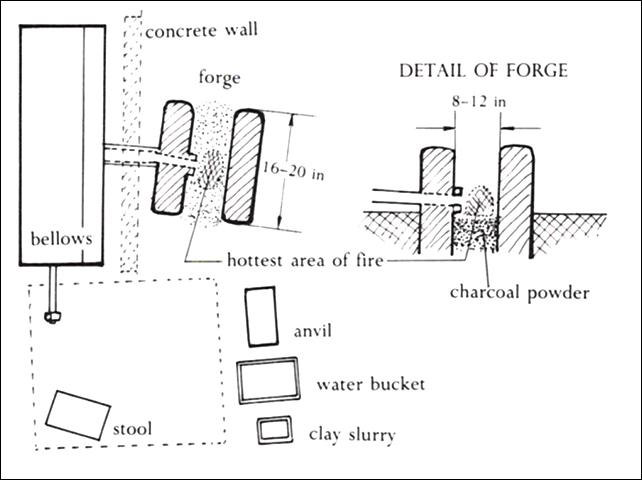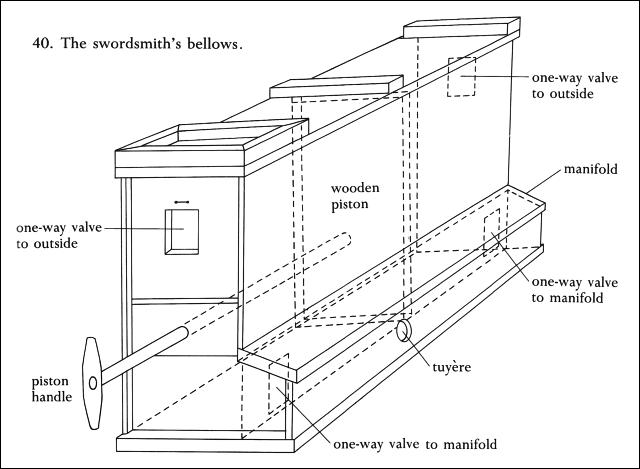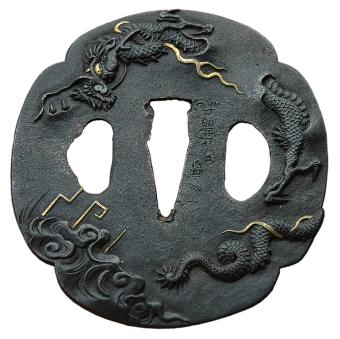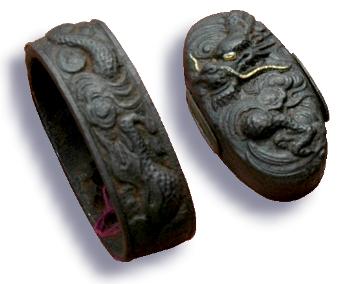|
|
|

|
Leon and Hiroko Kapp and
Yoshindo Yoshihara
The Craft of the
Japanese Sword
168 Pages, B&W, 8 color plates size 7-1/2" x 10-1/2"
Color slip cover
|
Book Review by Jock Dempsey
This is one of the few books written by people inside the industry who know the subject of the Japanese sword.
There is no fantasy, no sales hype, no myths.
The book is about the modern renaissance in making the traditional Japanese Sword and its methods of manufacturing.
The Authors are collectors and appraisers who with makers carefully assembled this work.
The fact that specialists make nearly every part of the sword is clearly illustrated by those consulted.
It is an important fact that these beautiful creations are not a product of "sole authorship" as many in the West believe.
Many experts were involved.
Thus the level of the art is much greater than one individual could normally create.
The blade was made by a sword smith, polished by a polisher, the furniture by metal artists, the sheath by another craftsperson and all may have organized by a dealer.

ABOVE: Sword tracing (oshigata) by Okisato Fujishiro. Fronticepiece illustration. Click for Detail.
The book covers every detail as well as can be expected in one reference.
While it shows every step in the process from making the iron and steel, shop layout and forge fires to polishing and fitting a sheath it is not a "how-to" book.
Among the details it includes fine variations in blades shape, clay heat treating, the hammon, tangs, filing textures, signatures and more.

Japanese Swordsmith's Shop Layout and forge detail
Throughout the East working on the ground has been traditional and is still the norm for many crafts workers.
In the West the invention of the screw vise is related to working at benches.
However, the reason for the difference goes back so far it can probably never be known.
The Japanese smith uses a modified system of working on the ground.
A pit lowers the smith and creates a raised surface for his bellows, forge and anvil.
For other process he may sit flat on the floor.

Oriental Box bellows. This drawing has been reproduced in many places on the web. Details
The above is not the only box bellows design, but it is one of the simplest.
Box bellows are also round cylinders and others boxes with the valves built into bottom so that they are a clean rectangular design without the "bird house" manifold on the side of the box.
Many served as a tool tote and work bench.
These were made by cabinet makers using fine joinery.
Auxiliary features included drawers for tools, file hangers for Chinese method filing and hangers for itinerant craftsmen to carry on a yoke.
See Details for more.

ABOVE: Black lacquered scabbards with braided hilts, by Kazuyuki Takayama, for katana.
"Ray skin is embedded in wet lacquer and polished until smooth to create the design."
The Craft of the Japanese Sword is complete in every detail, clearly written and probably the most authoritative book on the subject.
If you are interested in the subject of Japanese swords. sword collecting or making swords then this book is a must for your library.
What others have to say
This is the BEST book I have seen on the subject of Japanese swords.
Fourth printing, 1990;
Kodanska International/USA Ltd., 114 5th Avenue, New York, NY 10011; ISBN 0-87011-798-X (later editions/publishers may exist).
The account is very straight-forward, with good, strong facts and none of the weird myths so favored in popular culture.
It gives you the deepest respect for the skill and the patience of these craftsmen.
It also does not shy from the more grizzly details of the earlier employment of these instruments.
Nothing sensational, just truthful.
- Bruce "Atli" Blackistone
. . . . . on the Japanese striking.
The sledge hammer heads are quite long with the eye up near the poll.
The hafts are slender and whippy.
Since the Japanese anvils are buried in the ground and only protrude from grade a few inches, the strikers are in a semi-crouch on the downswing. Ref; "The Craft of the Japanese Sword", by Kapp & Yoshihara, Kodansha International, 1987.
In Japan, the smiths are very particular about their charcoal quality and size. The smiths use pine charcoal.
We were told by Yataiki, a sawsmith, that they use the Japanese red pine.
From The Craft of the Japanese Sword we learn that the apprentices spend large amounts of time breaking up the charcoal into specific sizes.
- Frank Turley
Added Material (not from book)


Dragon Tsuba and furniture in wrought iron and gold.
Photographed by Jock Dempsey at the 2007 Larry Harley Bladesmithing Hammer-In.
The Japanese sword was designed to be easy to change from plain "work" furniture to fancy dress furniture.
The dress furniture on the Japanese Sword was the work of artists who specialized in this work.
Links:
Published by: Kodansha America, Inc., Kodansha International (Japan)
17-14 Otowa 1-chome
Bunkyo-ku, Tokyo
112-8652
Copyright © 1987
ISBN 0-87011-798-X (U.S.)
ISBN 4-7700-1298-5 (Japan)
$45.00
|
|
|
Yoshindo Yoshihara
Japanese Sword
168 Pages, B&W, 8 color plates size 7-1/2" x 10-1/2"
Color slip cover
Book Review by Jock Dempsey
This is one of the few books written by people inside the industry who know the subject of the Japanese sword. There is no fantasy, no sales hype, no myths. The book is about the modern renaissance in making the traditional Japanese Sword and its methods of manufacturing.The Authors are collectors and appraisers who with makers carefully assembled this work. The fact that specialists make nearly every part of the sword is clearly illustrated by those consulted. It is an important fact that these beautiful creations are not a product of "sole authorship" as many in the West believe. Many experts were involved. Thus the level of the art is much greater than one individual could normally create. The blade was made by a sword smith, polished by a polisher, the furniture by metal artists, the sheath by another craftsperson and all may have organized by a dealer.
ABOVE: Sword tracing (oshigata) by Okisato Fujishiro. Fronticepiece illustration. Click for Detail.
The book covers every detail as well as can be expected in one reference. While it shows every step in the process from making the iron and steel, shop layout and forge fires to polishing and fitting a sheath it is not a "how-to" book. Among the details it includes fine variations in blades shape, clay heat treating, the hammon, tangs, filing textures, signatures and more.
Japanese Swordsmith's Shop Layout and forge detail
The Japanese smith uses a modified system of working on the ground. A pit lowers the smith and creates a raised surface for his bellows, forge and anvil. For other process he may sit flat on the floor.
Oriental Box bellows. This drawing has been reproduced in many places on the web. Details
ABOVE: Black lacquered scabbards with braided hilts, by Kazuyuki Takayama, for katana.
"Ray skin is embedded in wet lacquer and polished until smooth to create the design."
The Craft of the Japanese Sword is complete in every detail, clearly written and probably the most authoritative book on the subject. If you are interested in the subject of Japanese swords. sword collecting or making swords then this book is a must for your library.
What others have to say
This is the BEST book I have seen on the subject of Japanese swords. Fourth printing, 1990; Kodanska International/USA Ltd., 114 5th Avenue, New York, NY 10011; ISBN 0-87011-798-X (later editions/publishers may exist). The account is very straight-forward, with good, strong facts and none of the weird myths so favored in popular culture. It gives you the deepest respect for the skill and the patience of these craftsmen. It also does not shy from the more grizzly details of the earlier employment of these instruments. Nothing sensational, just truthful.- Bruce "Atli" Blackistone
. . . . . on the Japanese striking.
The sledge hammer heads are quite long with the eye up near the poll. The hafts are slender and whippy. Since the Japanese anvils are buried in the ground and only protrude from grade a few inches, the strikers are in a semi-crouch on the downswing. Ref; "The Craft of the Japanese Sword", by Kapp & Yoshihara, Kodansha International, 1987.
In Japan, the smiths are very particular about their charcoal quality and size. The smiths use pine charcoal. We were told by Yataiki, a sawsmith, that they use the Japanese red pine. From The Craft of the Japanese Sword we learn that the apprentices spend large amounts of time breaking up the charcoal into specific sizes.
- Frank Turley
Added Material (not from book)
Dragon Tsuba and furniture in wrought iron and gold. Photographed by Jock Dempsey at the 2007 Larry Harley Bladesmithing Hammer-In.
Links:
Published by: Kodansha America, Inc., Kodansha International (Japan)
17-14 Otowa 1-chome
Bunkyo-ku, Tokyo
112-8652
ISBN 0-87011-798-X (U.S.)
ISBN 4-7700-1298-5 (Japan)
$45.00